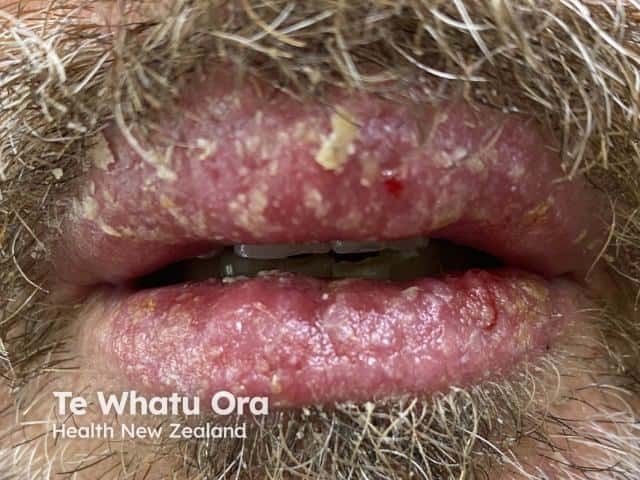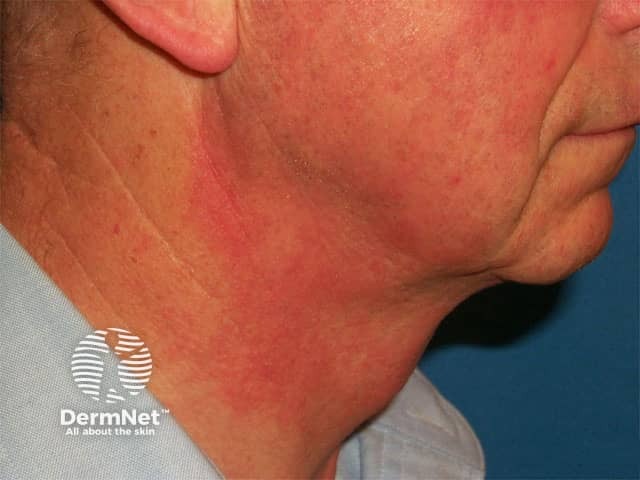Main menu
Common skin conditions

NEWS
Join DermNet PRO
Read more
Quick links
Contact reactions to cosmetics — extra information
Contact reactions to cosmetics
February 2023
Authors: Vanessa Ngan (2012); Tu-An Ma, University of Adelaide, Australia (2023)
Reviewing dermatologist: Dr Ian Coulson
Edited by the DermNet content department
Introduction
Cosmetics standard authorities
Demographics
Causes
Clinical features
Variation in skin types
Complications
Diagnosis
Differential diagnoses
Treatment
Prevention
Outcome
What is a cosmetic?
A cosmetic is a topical product designed to improve the odour, appearance, or cleanliness of an external body part.
Examples of cosmetics include:
- Facial make-up products: foundation, concealer, eye make-up, bronzer, blush, lipstick (see also: Contact reactions to lipsticks and other lip care products)
- Cosmetic camouflage products for the body (eg, to cover a scar or birthmark)
- Nail products: polish, nail hardener, nail-biting deterrent, varnish, polish/varnish remover, artificial nails (see also: Nail cosmetics allergy)
- Skincare products: cleanser, toner, emollients and moisturisers, fake tan
- Hair products: shampoo, conditioner, hair colour (eg, tint, dye), bleach, hairspray, gel
- Shaving products: shaving cream or foam, aftershave
- Dental and oral care products: toothpaste, mouthwash, teeth whitener
- Fragrances and perfumes, colognes, deodorants, and antiperspirants.
Although cosmetics and therapeutic agents (drugs) classification vary around the world, it can generally be based on their designed intention; cosmetic or therapeutic.
- Cosmetic products aim to ‘beautify’ or cleanse the skin, hair, teeth, or nails.
- Therapeutic products aim to prevent, diagnose, and/or treat a disease or condition.
Many products have both cosmetic and therapeutic functions. For example:
- Anti-dandruff shampoo (cosmetic as used to cleanse the hair, and therapeutic as contains anti-dandruff treatment)
- Toothpastes that contain fluoride
- Makeup products that are also sunscreens.
Cosmetic injectables such as botulinum toxin can also have cosmetic uses (eg, smoothing out lines and wrinkles) and therapeutic indications (eg, hyperhidrosis).

Acute weepy facial eczema due to beard dye allergy

Eczema of the lips due to propyl gallate allergy in a lip salve

Allergic contact dermatitis due to perfume in aftershave
Cosmetics standard authorities
Regulatory standards ensure cosmetic products are safe for handling, the environment, and use by consumers. These include:
- United States — Food and Drug Administration (FDA): Federal Food, Drug, and Cosmetic Act
- European Union — European Commission Regulation (EC) No. 1223/2009 (Cosmetics Product Regulation) and subsequent amendments
- United Kingdom — the Cosmetic, Toiletry and Perfumery Association (CTPA): Schedule 34 of the Product Safety and Metrology Statutory Instrument
- Australia — Australian Industrial Chemicals Introduction Scheme; and the Therapeutic Goods Administration (TGA) for cosmetics with therapeutic claims
- New Zealand — Environmental Protection Authority (EPA): Cosmetic Products Group Standard.
Who gets contact reactions to cosmetics?
Contact reactions to cosmetics are common. It is estimated that the average adult uses 6–12 cosmetic products daily. Pooled data from several studies in Europe and the United States found a prevalence of ~10% of cosmetic allergy in patients undergoing patch testing. Underreporting of cosmetic reactions is likely as many reactions are mild and self-limiting, and often self-managed. In one study in the United Kingdom, 57% of women and 31% of men self-reported having ever had an adverse reaction to a cosmetic product; 23% of women and 14% of men self-reported this had occurred within the preceding year (Willis et al, 2001).
Some people may develop more than one type of contact skin reaction. For example, an atopic individual may be prone to irritant contact dermatitis, which in turn increases their likelihood of allergic contact dermatitis, as their skin barrier function is weakened and sensitised to the allergen.
It is possible for a cosmetic allergy to develop even after years of using a cosmetic without previous problems.
What causes contact reactions to cosmetics?
Any constituent of a cosmetic has the potential to cause a contact reaction. Ingredients that appear to most frequently cause cosmetic reactions are fragrances, preservatives, and paraphenylenediamine (PPD) (found in many hair dyes).
Fragrances
- There are more than 5000 different fragrances used in cosmetics and skincare products.
- They are present in many cosmetics, including perfumes, shampoos, conditioners, moisturisers, facial cosmetics, and deodorants.
- Fragrances are the most common source of contact dermatitis from cosmetics.
- 70–80% of fragrance allergy can be picked up by patch testing with fragrance mix and Balsam of Peru.
- ‘Unscented’ does not always mean fragrance-free; a fragrance material may be used to neutralise or mask chemical odour/s from other ingredients. Generally, products labelled as ‘fragrance-free’ or ‘without perfume’ do not contain fragrances or masking scents.
Preservatives
- Preservatives are the second most common allergen, causing allergic contact dermatitis to cosmetics.
- Water-containing cosmetics contain antimicrobial preservatives to prevent bacterial or fungal growth.
- Antioxidants are another type of preservative added to prevent the breakdown of unsaturated fatty acids in cosmetic products.
- Some of the preservatives most commonly found in cosmetics include:
- Parabens – used in many facial cosmetics and skincare products
- Formaldehyde – mainly found in shampoos
- Imidazolidinyl urea
- Quaternium-15
- Isothiazolinone and, especially, methylisothiazolinone.
Paraphenylenediamine in hair dye
- Paraphenylenediamine (PPD) is the third most common cosmetic ingredient after fragrances and preservatives to cause allergic contact dermatitis.
- It is used widely in permanent hair dyes because it results in a natural colour.
- Reactions to PPD may be mild and involve dermatitis to the upper eyelids or rims of the ears, or may be more severe with swelling of the scalp, face and more widely.
- New derivatives of PPD have a lower risk of causing an allergy.
Other ingredients
Other irritants/allergens used in cosmetics include:
- Wool alcohol (eg, lanolin)
- Coconut diethanolamide
- Glyceryl monothioglycolate
- Methyldibromoglutaronitrile
- Rosin (colophony)
- Propolis
- Thiomersal
- Sunscreen allergens
- Nail cosmetic allergens
- Cobalt
- Glucosies (octyl and decyl) - foaming agents
What are the clinical features of contact reactions to cosmetics?
Cosmetics can produce a range of adverse reactions. Different products can result in different reaction patterns. For example, cheilitis can be caused by lip care products, while lateral facial dermatitis is often consistent with a reaction to a ‘rinse off’ product such as a shampoo or conditioner that runs down over the sides of the face and neck.
Contact urticaria
- Contact urticaria appears within minutes to one hour after allergen contact with skin.
- It generally presents with localised burning, itching, or tingling.
- Swelling and redness (wheal and flare) may be seen.
- The rash is usually transient and resolves within 24 hours.
Irritant contact dermatitis
- Irritant contact dermatitis accounts for 80% of all cases of contact dermatitis.
- People with atopy are more prone to irritant dermatitis than those without atopy.
- Dermatitis usually begins as patches of itchy, scaly skin or red rash, and can also present as blisters that ooze.
- For strong irritants, a reaction may occur within minutes or hours of exposure.
- For weaker irritants, it may take days or weeks of continued exposure before symptoms appear.
Allergic contact dermatitis
- Allergic contact dermatitis occurs when the immune system is sensitised to an allergen.
- A rash usually develops more than 12 hours after contact with the allergen and peaks around 48 hours after exposure.
- Symptoms of this allergic reaction include redness, swelling, intense itching, and urticated erythema.
- The face, lips, eyes, ears, and neck are the most common sites for cosmetic allergy.
Photocontact dermatitis
- Photocontact dermatitis is caused by the interaction of sunlight with an ingredient in the cosmetic.
Anaphylaxis
- Anaphylaxis can cause skin changes, difficulty in breathing, airway obstruction, nausea and vomiting, diarrhoea, tremor, and collapse.
- Skin changes include itching, hot and flushed skin, acute urticaria, and angioedema.
- Symptoms usually occur within an hour of allergen contact, although can appear later.
- It is rare but can be fatal.
- There are reports of death from anaphylaxis to paraphenylenediamine (PPD), the allergen in permanent hair dye.
How do clinical features vary in differing types of skin?
Erythema may be less evident in darker skin types, and postinflammatory hyperpigmentation is more common.
What are the complications of contact reaction to cosmetics?
- Secondary skin infection
- Chronic inflammation can cause lichenification
- Anaphylaxis is rare but can be fatal.
How is contact reaction to cosmetics diagnosed?
Cosmetic allergy is diagnosed through patch testing. A diagnosis may be made through testing against various possible allergens. Some allergens that may be found in cosmetics are present in baseline series of patch test allergens, and a specific Cosmetics Series has also been developed. See individual contact allergens for patch-testing recommendations.
A repeat open application test may also be recommended, and repeated open application tests may be useful when patch tests continue to produce negative results. The cosmetic is applied twice a day for 10 days to the same site (often on the inner forearm) and any reaction noted.
What are the differential diagnoses for contact reactions to cosmetics?
- Seborrhoeic dermatitis
- Atopic dermatitis
- Rosacea
- Other forms/causes of dermatitis or urticaria
What is the treatment for contact reaction to cosmetics?
General measures
- Avoid contact with the original source of allergen, and products containing the allergen (if known).
Specific measures
- Bland emollients to soothe and relieve dryness.
- Topical steroids to control itching, swelling, and redness.
- Antibiotics for secondary bacterial infection if required.
How do you prevent contact reactions to cosmetics?
- Read the list of ingredients on products for allergen avoidance.
- Test new cosmetics by placing a small sample of the product on the inner wrist or elbow and observe for any reaction over 24–48 hours.
- Look for products labelled as hypoallergenic, fragrance-free, and non-comedogenic. However, be aware that reactions may still occur with these products.
What is the outcome of contact reactions to cosmetics?
Most contact reactions to cosmetics are mild and will improve after the allergen source is identified and avoided. Irritant contact dermatitis is more common than allergic contact dermatitis. Prolonged symptoms or the symptoms of anaphylaxis (eg, angioedema and airway swelling) should be reviewed promptly by a clinician.
Bibliography
- Alani JI, Davis MDP, Yiannias JA. Allergy to Cosmetics: A Literature Review. Dermatitis. 2013;24(6):283–290. doi: 10.1097/DER.0b013e3182a5d8bc Abstract
- Cosmetics and therapeutics. Australian Government: Department of Health and Aged Care. Updated October 5, 2021. Accessed November 23, 2022. Available here
- Hafner MFS, Rodrigues AC, Lazzarini R. Allergic contact dermatitis to cosmetics: retrospective analysis of a population subjected to patch tests between 2004 and 2017. An Bras Dermatol. 2020 Nov-Dec;95(6):696–701. doi: 10.1016/j.abd.2020.04.011. Journal
- Fonancier L, Frankel D, Mawhirt S. Contact allergens for the allergist. Annals of Allergy, Asthma & Immunology. 2022;128(6):629–644. doi: 10.1016/j.anai.2022.03.022. Journal
- Hamilton T, de Gannes GC. Allergic Contact Dermatitis to Preservatives and Fragrances in Cosmetics. Skin Therapy Letter. 2011;16(4):1–4. PMID: 21611680. Journal
- Orton DI, Wilkinson JD. Cosmetic allergy: incidence, diagnosis, and management. Am J Clin Dermatol. 2004;5(5):327–337. doi: 10.2165/00128071-200405050-00006. Journal
- Smith V and Wilkinson, M. Cosmetics. In: Johansen J, Lepoittevin JP, Thyssen J, eds. Quick Guide to Contact Dermatitis. Springer; 2016:257–273.
- Willis CM, Shaw S, De Lacharrière O, et al. Sensitive skin: an epidemiological study. British Journal of Dermatology. 2001;145(2):258–263. doi: 10.1046/j.1365-2133.2001.04343.x. Journal
- Zirwas MJ. Contact Dermatitis to Cosmetics. Clinic Rev Allerg Immunol. 2019;56:119–128. doi: 10.1007/s12016-018-8717-9. Abstract
On DermNet
- Contact allergens
- Contact dermatitis
- Irritant contact dermatitis
- Allergic contact dermatitis
- Contact urticaria
- Photocontact dermatitis
- Anaphylaxis
- Contact reactions to lipsticks and other lip care products
- Nail cosmetics allergy
- Patch testing
- Open application test
- Baseline series of patch test allergens
Other websites
- Cosmetics — United States Food and Drug Administration (FDA)
- Cosmetics — European Commission
- United Kingdom Cosmetics, Toiletry and and Perfumery Association (CTPA)
- Australian Industrial Chemicals Introduction Scheme — Australian Government
- Cosmetics — New Zealand Environmental Protection Agency (EPA)
